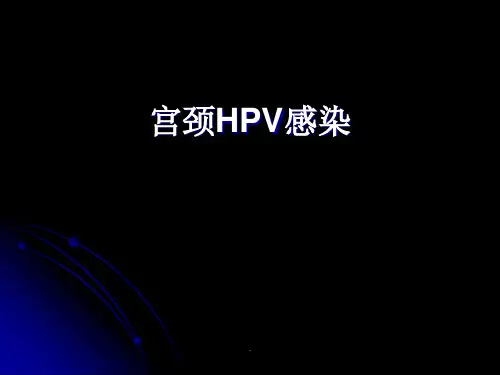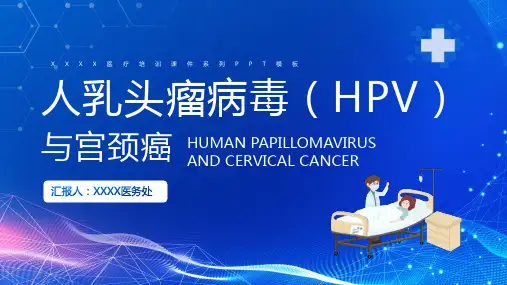HPV感染治疗的临床管理路径.3ppt
- 格式:ppt
- 大小:19.74 MB
- 文档页数:64










HPV治疗方案英语PPTIntroductionHuman Papillomavirus (HPV) is a common sexually transmitted infection that can cause various diseases, including cervical cancer. Although HPV cannot be cured, there are several treatment options available to manage the symptoms and reduce the risk of complications. In this presentation, we will discuss the different treatment approaches for HPV.Slide 1: Overview of HPVHPV is a DNA virus that infects the skin and mucous membranes of humans. It is transmitted through sexual contact and can lead to genital warts, cervical cancer, and other types of cancer.•More than 100 types of HPV have been identified.•HPV infections are common, and most people will have at least one type of HPV at some point in their lives.•Many HPV infections go away on their own without causing any symptoms or health problems.•Certain high-risk types of HPV can persist in the body and lead to cervical cancer.Slide 2: Prevention is the KeyThe best way to prevent HPV infection is through vaccination and safe sex practices.1.Vaccination: HPV vaccines are available for females and males. Thevaccines are most effective when administered before sexual activity begins.2.Safe sex practices: Using condoms consistently and correctly can helpreduce the risk of HPV transmission. However, condoms do not providecomplete protection since HPV can infect areas not covered by the condom.Slide 3: Managing HPV SymptomsAlthough most HPV infections do not cause any symptoms, some people may experience genital warts or other complications. The treatment options for managing HPV symptoms include:1.Topical Medications: Over-the-counter creams containing imiquimodor podophyllin can be applied to the affected area to treat genital warts. These creams stimulate the immune system to fight the virus and help reduce wartgrowth.2.Cryotherapy: This procedure involves freezing the warts with liquidnitrogen. It destroys the warts and stimulates the immune system to clear the virus.3.Electrosurgery: In this procedure, an electric current is used to burnor destroy the warts.ser Therapy: High-intensity laser beams are used to destroy thewarts.5.Surgery: In cases where the warts are large or do not respond to othertreatments, surgical removal of the warts may be necessary.Slide 4: Screening for HPV-Related CancersRegular screening is crucial for early detection and treatment of HPV-related cancers, especially cervical cancer. The screening options include:1.Pap Test: This test involves collecting cells from the cervix andexamining them under a microscope to detect any abnormal changes.2.HPV Test: A sample of cells from the cervix is tested for the presenceof high-risk HPV types.3.Co-Testing: Both Pap and HPV tests are performed together. Thisapproach is recommended for women aged 30 and older.Slide 5: Treating HPV-Related CancersIf HPV-related cancers are detected, various treatment options are available depending on the type and stage of cancer. These include:1.Surgery: Surgical removal of the affected tissue or organ may beperformed. This can include procedures such as a hysterectomy (removal of the uterus) or a cone biopsy (removal of a cone-shaped piece of tissue from thecervix).2.Radiation Therapy: High-energy x-rays are used to destroy cancercells. This treatment may be used alone or in combination with surgery.3.Chemotherapy: Anti-cancer drugs are used to kill cancer cells or stoptheir growth. Chemotherapy may be given before surgery to shrink tumors or after surgery to destroy any remaining cancer cells.Slide 6: Follow-Up CareAfter treatment, regular follow-up visits are necessary to monitor for recurrence and manage any side effects of treatment. These visits may include:1.Physical examination: The healthcare provider will examine thepatient and check for any signs of recurrence.2.Imaging tests: X-rays, CT scans, or MRIs may be done to detect anynew or recurring tumors.3.Blood tests: Blood samples may be taken to check for tumor markersor other indicators of cancer.4.Counseling and support: Patients may be referred to support groupsor counseling services to help cope with the emotional and psychologicalimpact of the diagnosis and treatment.ConclusionHPV treatment aims to manage symptoms, reduce the risk of complications, and prevent the development of HPV-related cancers. Vaccination, safe sex practices, regular screening, and early treatment are key components of an effective HPV management plan. By following these strategies, individuals can minimize the impact of HPV on their health and well-being.Remember, prevention is always better than cure, and staying informed about HPV and its treatment options is essential for maintaining good sexual health.。
